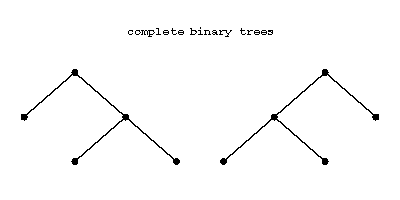Binary tree
A (planar) rooted tree for which every node has a left child, a right child, neither, or both. Three examples are:

Figure: b110530a
These three are all different.
The number of binary trees with  nodes,
nodes,  left children,
left children,  right children (
right children ( ) is
) is
 |
The numbers  are called Runyon numbers or Narayama numbers.
are called Runyon numbers or Narayama numbers.
A complete binary tree is one in which every node has both left and right children or is a leaf (i.e., has no children). E.g., there are two complete binary trees with five nodes:

Figure: b110530b
A complete binary tree has an odd number of nodes, say  , and then the number of leaves is
, and then the number of leaves is  . Label the
. Label the  leaves from left to right with symbols
leaves from left to right with symbols  . Then the various complete binary trees with their
. Then the various complete binary trees with their  leaves labelled in this order precisely correspond to all the different ways of putting brackets in the word
leaves labelled in this order precisely correspond to all the different ways of putting brackets in the word  , each way corresponding to a computation of the product by successive multiplications of precisely two factors each time. The number of ways of doing this, and hence the number of binary trees with
, each way corresponding to a computation of the product by successive multiplications of precisely two factors each time. The number of ways of doing this, and hence the number of binary trees with  nodes, is the Catalan number
nodes, is the Catalan number
 |
The problem of all such bracketings of a product (of numbers) was considered by E. Catalan in 1838 [a1].
The correspondence between complete binary trees and (complete) bracketings gives a bijection between complete binary trees with leaves labelled with elements from a set  and the free magma on
and the free magma on  .
.
References
| [a1] | E. Catalan, "Note sur une équation aux différences finies" J. Math. Pures Appl. , 3 (1838) pp. 508–516 |
| [a2] | L. Comtet, "Advanced combinatorics" , Reidel (1974) |
| [a3] | I.M. Gessel, R.P. Stanley, "Algebraic enumeration" R.L. Graham (ed.) M. Grötschel (ed.) L. Lovacz (ed.) , Handbook of Combinatorics , II , Elsevier (1995) pp. 1021–1062 |
| [a4] | R.P. Stanley, "Enumerative combinatorics" , Wadsworth and Brooks/Cole (1986) |
Binary tree. Encyclopedia of Mathematics. URL: http://encyclopediaofmath.org/index.php?title=Binary_tree&oldid=18931